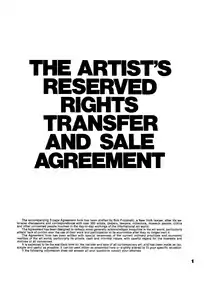The Artist's Reserved Rights Transfer and Sale Agreement
The Artist's Reserved Rights Transfer and Sale Agreement (also known as the Artist's Contract) was created by curator, dealer, and publisher of conceptual art Seth Siegelaub, and lawyer Robert Projansky. The Artist's Reserved Rights Transfer and Sale Agreement, according to Siegelaub, defined and attempted to protect the rights and interests of the artist as their work circulated within the art world system.[1]

The Artist's Contract was first published by the School of Visual Arts, New York, as a fold out poster. One side features an introductory text by Siegelaub explaining the principles behind the Contract, how it was research, and instructions for use. On the reverse is the contract itself, authored by Projansky. The final page of the contract portion features a form that must be signed by the artist and the collector of their work, and is intended to be affixed to the artwork itself. Artists were encouraged to reproduce the Contract multiple times and to use it in any transfer of their work.
The Contract contains many controversial clauses. Article 7 gives artists the right to veto the exhibition of their sold works. Article 2 stipulates that collectors agree to give the artist a resale royalty of 15% of the increase in price over the initial sale. The Contract is also designed to create transparency in transactions where artworks are resold.
Publication
The Artist's Contract was translated into French, German, Dutch and Italian in the early 1970s. A new Dutch translation was produced for the exhibition "Seth Siegelaub: Beyond Conceptual Art" at the Stedelijk Museum, Amsterdam, 2015. The French version of the Contract was edited by lawyer Michel Claura to be appropriate for use in the French legal context.
The Artists Contract has been republished numerous times in art magazines and art historical studies, and legal resource books. Arts magazines in which The Contract was reproduced include: Studio International, April 1971; Art News, April 1971; Arts Canada, April 1971; Domus, April 1971; New York Element, June–July 1971; museumjournaal, September 1971; documenta 5, 1972; Bulletin, October 1972; Leonardo, June 1973
A PDF of the Artists Contract is available through Primary Information[2]
In 2009 German artist Maria Eichhorn produced the book The Artists Contract[3] featuring interviews with artists using the contract including Jackie Windsor and Hans Haacke, and others who were present for its development, such as Lawrence Weiner, Robert Barry, Carl Andre, and others. Artist Adrian Piper, who uses a modified version in the sale of her work, was interviewed as well.
Notes
- "Stichting Egress Foundation".
- http://www.primaryinformation.org/pdfs/
- Eichhorn, Maria, and Gerti Fietzek. The Artist’s Contract: Interviews with Carl Andre, Daniel Buren, Paula Cooper, Hans Haacke, Jenny Holzer, Adrian Piper, Robert Projansky, Robert Ryman, Seth Siegelaub, John Weber, Lawrence Weiner, Jackie Winsor. Köln; New York: Verlag der Buchhandlung Walther König ; Distribution, D.A.P./Distributed Art Publishers, 2009.